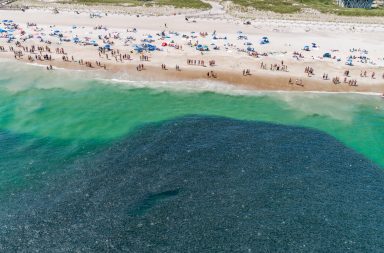After the suspected shark attacks yesterday, there have been multiple reports of Sharks targeted and caught from local beaches. As a reminder, all of the sharks caught in the vicinity of the beach are protected and prohibited from being caught without a special permit. Furthermore, they should never be dragged on the beach or manipulated for photos. Violations can result in fine or imprisonment. The NYS DEC website has more information on identifying prohibited Sharks and what to do if one is inadvertently hooked. Reprinted below with permission. Shark Fishing- NYS DEC
Shark Fishing
Shark fishing is popular with recreational and tournament anglers in New York. Before you head out to try your luck at shark fishing, you must first register with the Recreational Marine Fishing Registry and apply for a federal Highly Migratory Species (HMS) permit (link leaves DEC website).
When fishing for sharks, you should be able to identify prohibited shark species and understand the rules associated with these species. For more detailed information about shark species identification, download and review the National Marine Fisheries Service (NMFS) Prohibited Shark Identification Placard and the Shark Identification Placard (links leave DEC website).
Prohibited Shark Species Rules
Commonly encountered prohibited shark species found in New York state waters include Sandbar (“Brown”), Dusky, and Sand Tiger sharks. These three species are primarily the only species of large (non-Dogfish) shark anglers will encounter from shore.
In New York State waters, it is illegal to take; or possess prohibited shark species. Do not fish for or target prohibited sharks.
Other species of prohibited shark found in the NY bight include the White, Basking, Whale, and Atlantic Angel sharks. For a full list of all prohibited shark species, view the Recreational Shark Limits.
Why are Certain Shark Species Prohibited?
Prohibited shark species share unique life history traits. They are generally long lived species which have slow growth, experience an older age at maturity, and produce few offspring. These life history traits leave these species especially vulnerable to the pressures that fishing has on their populations. The prohibited status gives these species the protection they need to maintain and rebuild their populations.
What to do if you Catch a Prohibited Shark
Treat any shark that you cannot identify as prohibited species and release it immediately.
Remember, “If you don’t know, let it go.”
If you catch a prohibited shark species…
From the Shore:
- NEVER drag a shark onto dry land beyond the surf zone. Sharks caught from shore should be left in as much water as possible while maintaining the safety of the angler and those nearby.
- Minimize release time. Do not delay release to take pictures.
- Do not sit on the shark or pull back the snout to reveal the teeth.
- Keep onlookers in the area well clear of the shark.
- If the shark is hooked in the jaw, use a long-handled dehooking device to help with hook removal or bolt cutters to cut the hook.
- If it is not possible to remove the hook, cut the leader as close to the hook as safely as the situation allows. Long lengths of leader left with the shark decrease its chance of survival after it is released.
- Minimize handling. Touching the shark can put yourself and others at risk. It can also remove the shark’s protective mucous layer and cause harm to the animal. If you need to handle the shark, use wet hands or a wet towel.
From a Boat:
- Minimize your fight time to prevent lethal exhaustion of the shark.
- Always keep the shark in the water alongside your boat with its snout facing into the current.
- Do not use a gaff. Instead hold the shark on the leader while moving the boat slowly ahead.
- If the shark is hooked in the jaw, use a long-handled dehooking device to help with hook removal or bolt cutters to cut the hook.
- If it is not possible to remove the hook, cut the leader as close to the hook as safely as the situation allows. Long lengths of leader left with the shark decrease its chance of survival after it is released.
- Before you go fishing, watch NOAA Fisheries video (link leaves DEC website) for more information about handling and release of prohibited shark species from a boat.

J-hook vs. Circle hook, Photo Credit: NOAA NMFS
Circle Hooks
When fishing for sharks with baited hooks, you are required to use non-stainless steel, non-offset circle hooks.
Non-stainless steel hooks deteriorate over time, reducing harm to a fish if you are unable to retrieve the hook. A circle hook’s point is turned back toward the shank, forming a semi-circle shape.
A circle hook is more likely to lodge in a shark’s mouth instead of its gut. A J-hook is more likely to be swallowed and damage a shark’s internal organs.
Continued on Page 2




